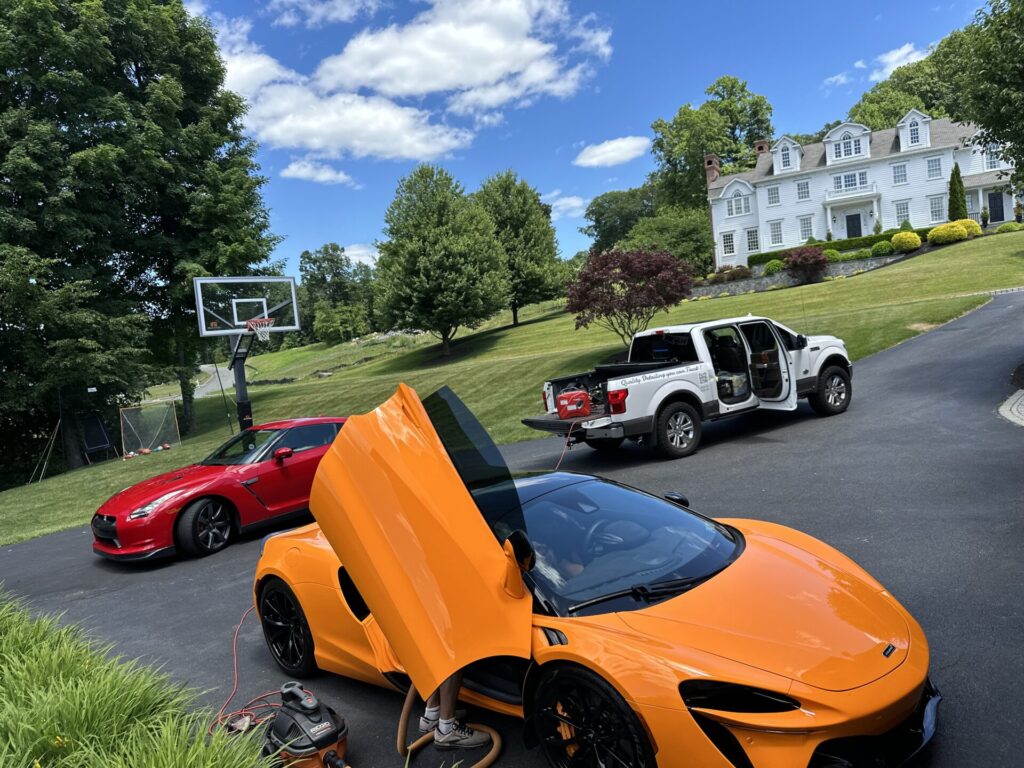Paint protection film (PPF) is the best way to shield your vehicle’s paint from damage caused by road debris, UV rays, and environmental contaminants. However, despite its benefits, PPF can develop issues such as lifting and bubbling, which can compromise both its appearance and effectiveness. In this guide, we’ll explore common PPF problems, their causes, and effective solutions to fix and prevent them.
Understanding common PPF problems
PPF-related issues often arise due to improper installation, environmental factors, or lack of maintenance. The two most common problems are:
- Lifting: When the edges or sections of the PPF start to detach from the vehicle’s surface, exposing the paint underneath.
- Bubbling: The formation of air or moisture pockets underneath the film, resulting in visible bubbles that can worsen over time.
Both of these issues, if left unaddressed, can reduce the effectiveness of the protective film and ruin the aesthetic appeal of your vehicle.
Causes of PPF lifting
Several factors contribute to the lifting of PPF, including:
- Improper surface preparation: The vehicle’s surface must be completely clean and free of wax, grease, and dirt before PPF installation. Contaminants prevent proper adhesion, leading to lifting.
- Poor installation techniques: Incorrect stretching, misalignment, or using insufficient slip solution during installation can cause premature lifting.
- Extreme temperature conditions: Installing PPF in very cold or humid conditions can negatively impact adhesion.
- Aging adhesive: Over time, PPF adhesive can degrade, especially with exposure to extreme weather.
How to fix PPF lifting
If you notice PPF lifting, follow these steps to fix the issue:

Steps to fix PPF lifting
- Clean the affected area: Gently lift the peeling section and clean both the film’s underside and the vehicle’s surface using mild soap and water. Ensure the area is completely dry before proceeding.
- Reapply the film: Once clean, carefully press the film back onto the surface, ensuring that there are no wrinkles or folds.
- Apply heat: Using a heat gun or hairdryer on a low setting, warm the affected area to reactivate the adhesive. Move the heat source in a circular motion to avoid overheating.
- Secure the film: Press the film firmly using a microfiber cloth or squeegee to eliminate air pockets and reinforce adhesion.
- Use an edge sealant: Applying a PPF edge sealant can provide extra adhesion and prevent future lifting. Be sure to use a product specifically designed for PPF.
- Monitor for further issues: After reapplication, observe the film over the next few days to ensure it stays in place and does not continue lifting.
Causes of PPF bubbling
Bubbling occurs when air or moisture gets trapped under the film. Common causes include:
- Trapped air or moisture: Improper squeegeeing during installation can lead to air or moisture pockets.
- Contaminants on the surface: If dust, dirt, or other particles are present during installation, they can cause bubbling over time.
- Improper use of slip solution: Using too little slip solution makes it difficult to reposition the film, while using too much can prevent proper adhesion.
How to fix PPF bubbling
To fix bubbling in PPF, follow these steps:
- Identify the bubble type: If the bubble contains moisture, it may evaporate on its own. If it contains air, intervention is needed. Press lightly on the bubble to determine if it is firm (air) or soft (moisture).
- Use a pin or needle: For persistent air bubbles, sterilize a fine pin and gently prick the edge of the bubble to release the trapped air. If dealing with moisture, avoid pricking; instead, apply heat and pressure to help it dissipate naturally.
- Apply heat: Gently warm the area with a heat gun or hairdryer on a low setting to soften the adhesive. Keep the heat source at least six inches away and move it in a circular motion to avoid overheating.
- Smooth the film: Use a squeegee or microfiber cloth to press the film down, starting from the center of the bubble and moving outward. Apply firm but gentle pressure to avoid stretching the film.

Steps to fix PPF bubbling
- Check for residual bubbles: Inspect the area after 24 hours. If bubbles persist, repeat the process, ensuring proper heat application and smoothing techniques.
- Prevent future bubbling: Avoid washing the vehicle for at least 48 hours after fixing bubbles, as moisture trapped during installation needs time to fully dry. Store the car in a dry, temperature-controlled environment to aid proper adhesion.
The best way to maintain PPF
Proper maintenance extends the lifespan of your PPF and keeps it looking great. Here are some key tips:
- Regular cleaning: Wash your vehicle using a pH-neutral soap and a microfiber cloth.
- Avoid harsh chemicals: Do not use abrasive cleaners, petroleum-based solvents, or harsh chemicals.
- Inspect periodically: Check your PPF for signs of lifting, bubbling, or discoloration.
- Use a PPF-safe wax or sealant: Applying a PPF-safe wax or sealant can enhance durability and provide extra UV protection.
Lear more: How to Maintain Your Car’s Shine All Year with Paint Protection Film
Trust expert PPF installation and maintenance services with Wax Masters Detailing!
If you’re experiencing persistent issues with your PPF, or if you’re considering getting PPF for your vehicle, consulting a certified installer will save you time, effort, and potential repair costs.
For the best professional PPF installation and maintenance services, trust Wax Masters Detailing. We take pride in delivering expert care and protection for your vehicle. Our team has the experience and knowledge to ensure flawless PPF application and long-term durability.
Call (973) 670-5350 to book an appointment, or visit us at 111 West Main Street, Rockaway, NJ 0786. Let us help you keep your vehicle looking pristine and protected for years to come.
